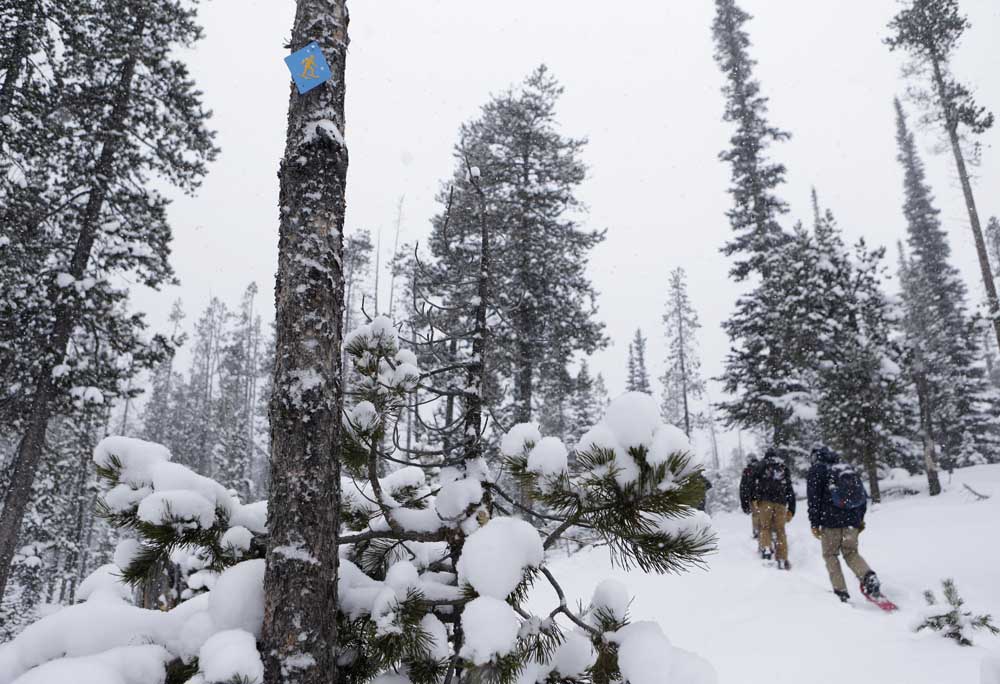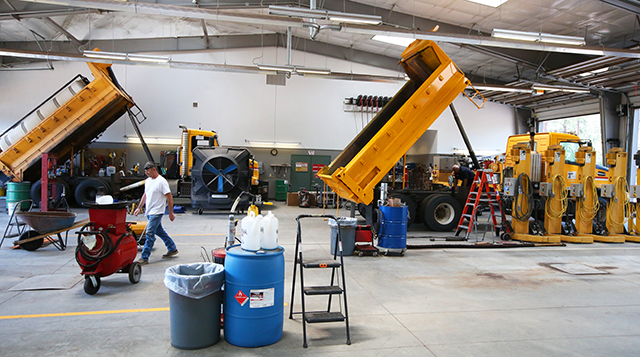Snowshoeing is another way to savor the powder
Published 12:00 am Thursday, March 1, 2018

- A blue diamond on a tree designates a snowshoe trail at the Swampy Lakes Sno-park.(Joe Kline/Bulletin photo)
James McGaley led a six-person snowshoeing expedition at Swampy Lakes Sno-park on a recent afternoon. Wearing snowboarding jackets and matching tan snow pants, the group of friends resembled a web-footed caterpillar as they trundled in their snowshoes through a knee-deep trail broken by other snowshoers.
The air temperature hovered around 20 degrees and pine trees wore dollops of powder that refracted the sunlight like granular prisms.
Trending
“It was magical. Enchanted,” Paul Schirmer later said with a chuckle.
It was the first time most of them had ever gone snowshoeing, and one of the few times they could savor cold, powdery snow that makes western mountains ski and snowboard destinations for the rest of the country.
Snowshoeing has been limited in Central Oregon to areas around the base of Mt. Bachelor ski area and Dutchman Sno-park until recent snowfall.
Snowshoers, like nordic skiers and snowmobilers, have delighted in the heaps of fresh snow that have blanketed lower elevation sno-parks that were previously patchy or altogether barren.
“Snowshoeing gives you more time to take in your peripherals, McGaley said, describing how satisfying he found the sensation of sliding down a hill covered in shin-deep powder while wearing snowshoes. He and Schirmer agreed that if they lived in Central Oregon they would definitely add snowshoes to their collection of outdoor gear.
“With snowshoes, it’s like you’re pillow-hopping,” McGaley said.
Trending
Visiting from Long Island, New York, the group delighted in the fresh powder that made days spent snowboarding and skiing at Mt. Bachelor a dream. The mountain received more than 30 inches during their week-long trip. McGaley and his friends chose to try out snowshoeing on a rest day before returning to Mount Bachelor — and perhaps Tumalo Mountain. The group rented their snowshoes from Pine Mountain Sports, which charges $15 for a day and directed them to Swampy Lakes Sno-park for their outing. Snowshoes can also be rented for 24-hour periods from Powder House ($14) and Mountain Supply ($10).
Snowshoe 101: gear and safety
Snowshoes feature boot straps and grippy platforms equipped with crampons. Modern snowshoes bind the boot with either a strap system or bindings that resemble lightweight versions of those for snowboarding. An unbound heel design allows hikers to walk naturally. Snowshoes keep users from “post-holing,” or sinking into the snow, by widening their weight distribution.
Trekking poles or ski poles are useful for stability, though not mandatory. Wearing waterproof lower-leg coverings that fit over the boot and the bottom of your pants prevents snow from getting packed into boots, which ideally also should be water-proof.
Traditional snow pants will work, too. And this should go without saying: Don’t wear jeans.
Dress in layers as if you’re going for a winter jog, and carry extra layers, along with water and snacks, in a backpack. Printing out trail maps and carrying a compass — and knowing how to use it — are also a good idea. Let a friend know where you are going to snowshoe and when you expect to be back. Not every outing unfolds as planned.
Etiquette
The U.S. Forest Service has clear rules set for winter users of Deschutes National Forest sno-parks. Snowshoers are directed to stick with dedicated snowshoe trails.
If you choose to use the ski trails for snowshoeing, do not stomp in the actual tracks; stay at least 2 feet to either side of a set ski track, the agency said. This way you won’t ruin the ski track and affect skiers’ enjoyment and safety.
No shortage of snowshoe options
While snowshoes can handle icy or slushy conditions, they’re ideal for the dry powder that has recently covered the Cascades.
Trails designated for snowshoes wind throughout the region’s sno-parks, most of which line Century Drive on the way toward Mount Bachelor from Bend. Virginia Meissner, Wanoga, Edison, Dutchman and Swampy Lakes sno-parks feature nearly 20 combined miles of dedicated snowshoe trails.
The most popular among them is Swampy Lakes Sno-park, which features more than 9 miles of snowshoe trails that crisscross ungroomed cross-country ski trails.
Blue diamond markers featuring pictograms of snowshoers mark the various trails.
A popular option for a trek under 2 hours is the 3.5-mile out-and-back to the Swampy Shelter.
On a recent afternoon, Randy and Barb Smith emerged through the sliding wooden doors of the shelter. Inside, a wood-burning stove kept the shelter “nice and toasty,” the couple said.
The Smiths opted for snowshoeing when poor visibility on Mount Bachelor dashed their hopes of skiing. Snowshoeing, which they do with the help of telescoping ski poles for added stability, is their second go-to winter activity, which the Sunriver residents enjoy about five times per year.
“Snowshoeing doesn’t take talent,” Randy said. “You just walk. It’s great exercise. Snowshoeing beats going to the gym.”
— Reporter: 541-617-7816, pmadsen@bendbulletin.com








